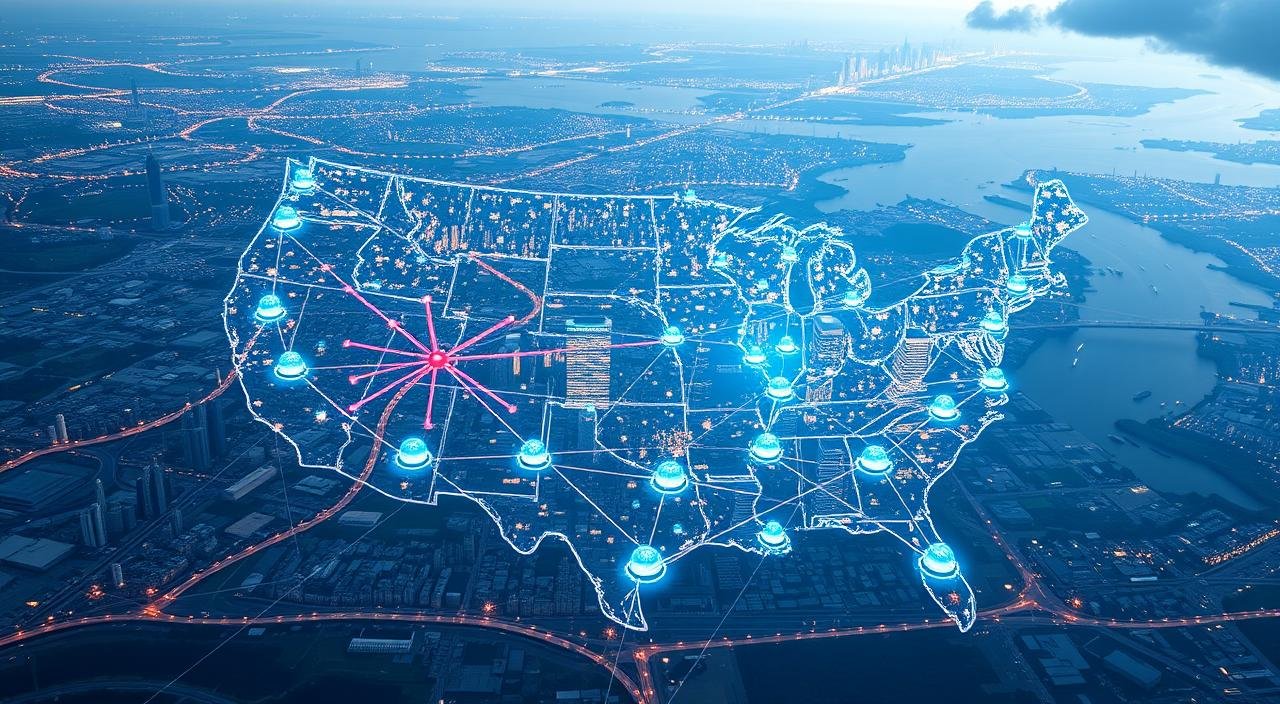5G Technology Expansion: Impact on US Connectivity
Have you ever pondered how 5G technology will change your daily life and the future of connectivity in America? The rapid expansion of 5G technology is more than just an upgrade. It marks a significant shift in US connectivity, affecting everything from telecommunications to transportation. As we explore the impact of 5G technology, you’ll see how faster internet speeds and better reliability can revolutionize industries and boost economic growth nationwide.
Key Takeaways
- The 5G technology expansion aims to deliver faster internet speeds and improved reliability across the US.
- Enhanced connectivity has the power to transform various sectors, including telecommunications and digital services.
- 5G is expected to democratize access to high-speed internet, fostering economic growth.
- Infrastructure development is key for supporting the continuous roll-out of 5G networks.
- Current trends show collaboration between government and private sector for advancing 5G initiatives.
- The impact of 5G technology will pave the way for innovations in the Internet of Things and smart cities.
Introduction to 5G Technology
The introduction to 5G marks a major advancement in mobile communication, aiming to revolutionize connectivity in our daily lives. This cutting-edge network promises ultra-fast data transfer and near-instant response times. As you dive into the realm of 5G technology, it’s evident that these enhancements are not just minor tweaks but a complete overhaul, setting it apart from 4G LTE.
5G technology goes beyond personal communication, empowering critical sectors like healthcare, education, and transportation. It supports a vast array of connected devices, laying the groundwork for the Internet of Things (IoT) and smart cities. This transformation is significant, bringing essential services and education to underserved areas through affordable 5G-enabled devices.
The telecommunications industry is witnessing fierce competition, with companies like Amdocs and Crnogorski Telekom investing in infrastructure for 5G services. This reflects the widespread understanding that 5G is vital for economic growth and digital transformation. Your grasp of its applications will be key as you move through this rapidly changing landscape.
| Feature | 4G LTE | 5G Technology |
|---|---|---|
| Data Transfer Speed | Up to 100 Mbps | Up to 10 Gbps |
| Latency | 30-50 ms | 1 ms |
| Device Capacity | 2,000 devices per km² | 1 million devices per km² |
| Use Cases | Basic mobile broadband | IoT, smart cities, connected vehicles |
Understanding 5G Technology Expansion
The evolution of mobile networks has reached a significant milestone with the introduction of 5G technology. This fifth generation of mobile network technology is designed to revolutionize connectivity around the globe. You might be wondering, what is 5G? This advanced system is not just about faster internet speeds; it encompasses improvements in coverage and reliability, opening doors to a plethora of applications in various sectors.
What is 5G?
5G technology represents a substantial leap from its predecessor, 4G LTE. It brings about enhanced mobile broadband, enabling users to download files and stream high-quality video seamlessly. It also supports massive IoT connectivity, allowing a vast number of devices to communicate simultaneously without significant delays. The enhanced capabilities of 5G stand to benefit multiple sectors, from healthcare to education.
Key Features of 5G Technology
When discussing the features of 5G, several key components come into play:
- Massive IoT Connectivity: 5G allows for a higher density of connected devices, making it ideal for smart cities and automated systems.
- Ultra-Reliable Low-Latency Communications (URLLC): This feature is critical for applications requiring real-time responses, such as remote surgeries and autonomous vehicles.
- Enhanced Mobile Broadband (eMBB): Improved data speeds enhance user experiences in virtual reality, gaming, and other bandwidth-intensive applications.
The 5G technology expansion is key in shaping the digital landscape. It fosters innovation and creates new opportunities for individuals and industries alike.
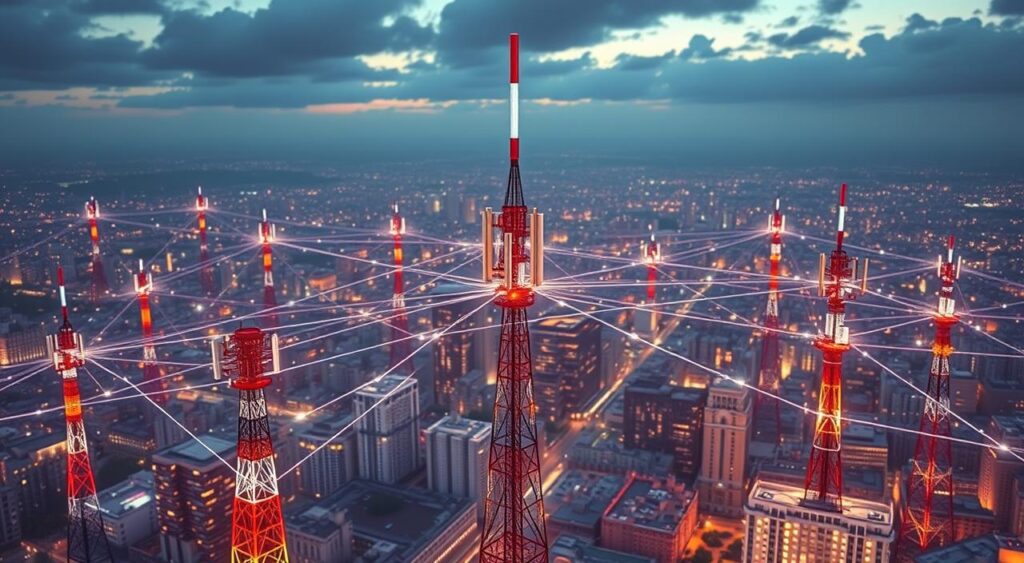
High-Speed Connectivity and Enhanced User Experience
The advent of 5G technology is a major step forward in high-speed connectivity. It changes how we interact with digital content. With more bandwidth, streaming high-definition videos, playing live games, and downloading large files becomes effortless. This upgrade not only improves personal tech experiences but also boosts business operations, meeting the need for instant information access.
The Impact of Faster Internet Speeds
Faster internet speeds bring numerous benefits, redefining what we expect from connectivity. For example, M1’s modernization in Singapore shows how 5G enhances service performance. The blending of prepaid and postpaid services with 4G and 5G capabilities highlights the importance of speed in today’s market. This technology speeds up service launches, enabling businesses to meet user needs quickly and ensure a strong network experience.
Improvement in Mobile Networks
Improving mobile networks is a key part of 5G’s expansion. It optimizes bandwidth and reduces lag, leading to better mobile communication and data services. The Moto G Stylus 5G is a prime example of how high-speed connectivity improves access in underserved areas. This connectivity boosts digital literacy and economic growth by increasing educational opportunities. It also leads to more efficient operations, paving the way for future innovations.
5G Technology Expansion and the Internet of Things (IoT)
The convergence of 5G technology and the Internet of Things (IoT) marks a significant shift in device connectivity and interaction. With the advent of 5G networks, everyday devices can now communicate seamlessly. This opens up new avenues for automation and control across various industries.
Connecting Everyday Devices
5G technology’s expansion enables more devices to join the IoT ecosystem. Its high-speed, low-latency features allow for real-time data exchange. This means appliances, vehicles, and wearable technology can communicate more efficiently. Such connectivity drives advancements in:
- Enhanced Automation: Smart home devices can respond instantly to user commands.
- Improved Monitoring: Health devices continuously relay important health data.
- Advanced Control Systems: Manufacturing processes can utilize IoT for real-time adjustments and optimization.
The Role of IoT in Smart Cities
In the evolution of urban environments, IoT’s role in smart cities becomes clear. 5G technology’s improved connectivity enhances various urban aspects, including:
| Smart City Feature | Description | Benefits |
|---|---|---|
| Smart Traffic Management | Real-time monitoring of traffic flow. | Reduced congestion and improved travel times. |
| Energy Management | Efficient use of energy resources. | Lower energy consumption and costs. |
| Resource Management | Integrated systems for waste collection and public services. | Optimized service delivery and reduced waste. |

The synergy of 5G technology and IoT in smart cities showcases the transformative power of interconnected systems. It promises to revolutionize urban living, making it more efficient and sustainable.
Digital Transformation Driven by 5G
The advent of 5G technology is catalyzing a significant digital transformation across various sectors. Businesses are now seeing the value in advanced connectivity, which enables the creation of innovative services and solutions. This, in turn, enhances customer experiences. Industries like healthcare, education, and retail are experiencing a transformation in their operations and service delivery.
In healthcare, telemedicine is transforming patient care through remote consultations and diagnostics, thanks to 5G. This technology increases healthcare access, improves speed, and enhances efficiency. Educational institutions are also benefiting, providing online learning experiences that are both interactive and engaging. These advancements improve student participation and understanding.
The retail sector is also experiencing changes. Augmented reality experiences, powered by 5G, offer immersive shopping experiences. This bridges the gap between digital and physical retail environments. Businesses can now tailor their marketing strategies to meet evolving customer expectations.
Amdocs’ modernization project for Singapore’s M1 is a prime example of digital transformation. They implemented a cloud-native charging platform that integrates prepaid and postpaid services, along with 4G and 5G functionalities. This initiative aims to address customer expectations in a price-sensitive market, ensuring scalability for future growth and quicker product launches.
The Chief Digital Officer of M1 highlighted the platform’s role in increasing network robustness. This illustrates how digital transformation can lead to operational efficiency and improved service delivery. Businesses are now focusing on strategic investments to drive innovation. They are allocating significant funds to startups specializing in quantum computing and AI-driven technologies.
By staying ahead of digital transformation trends, your business can gain a competitive edge. Utilizing 5G technology allows for innovation and optimization of your offerings. The landscape is evolving rapidly, and the benefits of adopting these advancements are immense.

| Sector | Impact of 5G Technology |
|---|---|
| Healthcare | Enhanced telemedicine services and remote diagnostics. |
| Education | Interactive online learning platforms. |
| Retail | Augmented reality shopping experiences. |
| Telecommunications | Integration of services with improved network capabilities. |
Infrastructure Development for 5G Networks
Effective 5G networks heavily depend on robust infrastructure development. The path to a full 5G experience requires significant investment in telecommunications infrastructure. This includes physical elements and advanced technologies for efficient deployment. As demand for faster, more reliable connections grows, so do financial commitments from public and private sectors.
Investment in Telecommunications Infrastructure
Building and upgrading telecommunications infrastructure is key for 5G technology’s success. Costs for developing cellular towers, data centers, and other facilities are high. Mobile operators must invest heavily to meet increased traffic and customer expectations. Projects like Amdocs’ modernization for Singapore’s M1 show how strategic investments boost service delivery and market competitiveness.
Collaboration Between Government and Private Sector
Government collaboration is vital for 5G network infrastructure development. Partnerships between governments and private companies can simplify funding and speed up deployment. These collaborations improve service reliability, security, and network strength. For example, Amdocs’ partnership with Crnogorski Telekom has led to advancements in billing and customer experience. As 5G technology grows, the partnership between sectors is critical for sustainable development.

Wireless Communication Advancements
The expansion of 5G technology marks a significant leap in wireless communication, impacting connectivity across various sectors. Enhanced frequencies and advanced antennas are key to delivering improved speed and reliability. This transformation breaks through existing limitations, enabling more connections in urban, suburban, and rural areas.
Several key factors contribute to these advancements in connectivity:
- Increased Bandwidth: Higher frequency bands enable wider channels, facilitating greater data transmission and faster speeds.
- Massive MIMO: Multi-Input Multi-Output technology enhances wireless network capacity by utilizing multiple antennas at both ends.
- Network Slicing: This method creates virtual networks tailored for specific applications, optimizing resource allocation and service delivery.
- Lower Latency: Reduced communication delays are critical for real-time responsiveness in applications like remote healthcare and industrial automation.
- Extended Coverage: Advanced signal processing ensures connectivity in challenging environments, overcoming distance and physical barriers.
These technological developments enhance user experiences and support the growth of the Internet of Things (IoT). As wireless communication advances, more devices can connect seamlessly, fostering a smarter, more efficient ecosystem.
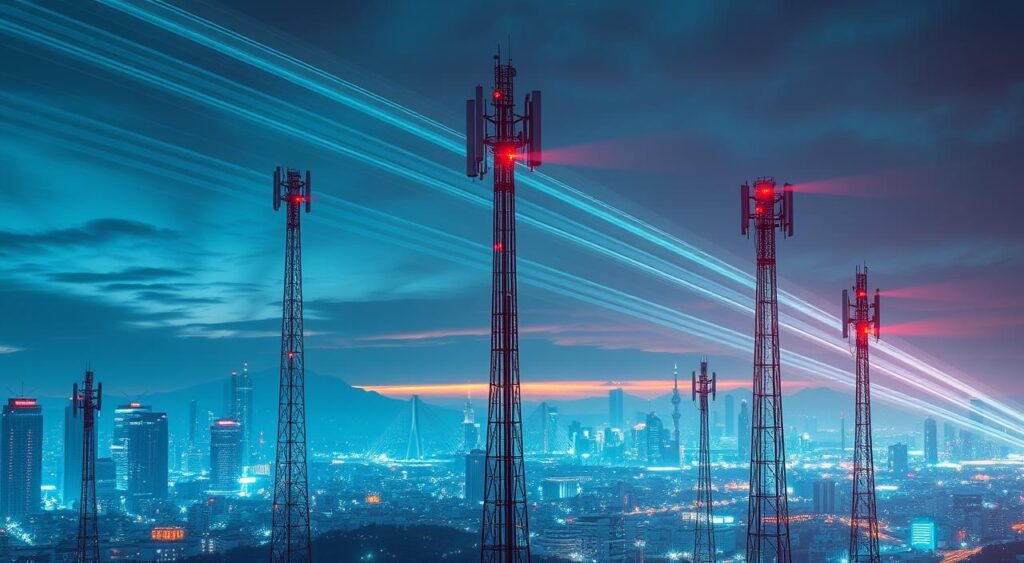
| Advancement | Description | Impact on Connectivity |
|---|---|---|
| Increased Bandwidth | Utilization of higher frequency bands for wider channels | Faster speeds and improved user experiences |
| Massive MIMO | Use of multiple antennas for better signal quality | Enhanced network capacity and performance |
| Network Slicing | Creation of virtual networks for tailored applications | Optimized resource allocation and robust service delivery |
| Lower Latency | Reduction in communication delays | Real-time responsiveness for critical applications |
| Extended Coverage | Advanced signal processing for improved connectivity | Reliable service across diverse environments |
As these innovations take root, the vastness of further advancements in wireless communication becomes apparent. This increases expectations for connectivity in your everyday life.
Challenges Facing 5G Technology Expansion
The journey to expand 5G technology is fraught with obstacles. Regulatory hurdles and public concerns stand out as major challenges. Telecom companies face a complex regulatory landscape, hindering swift network deployment. These hurdles can cause delays and increase costs, affecting the rollout’s pace.
Regulatory and Policy Hurdles
The regulatory framework for telecommunications is complex. Different jurisdictions have varying rules, leading to inconsistent approval processes. Key challenges include:
- Permitting delays hindering site acquisition for essential towers
- Local ordinances affecting the placement and aesthetics of equipment
- Conflicting regulations between federal and state authorities
Addressing these regulatory hurdles is essential for 5G network expansion. Collaboration between governments and industry can streamline processes. This cooperation can lead to faster 5G deployment.
Public Concerns and Misconceptions
Public fears about 5G often stem from misconceptions about health risks and data privacy. These concerns can slow acceptance and hinder progress. Main concerns include:
- Perceived health risks associated with increased electromagnetic radiation
- Worries about the security of personal data transmitted over 5G networks
- Uncertainty about the implications of widespread device connectivity
Addressing these concerns requires clear communication and education. Highlighting 5G’s benefits while addressing health and privacy issues is vital. Accurate information can help bridge the gap between technological advancements and public understanding.
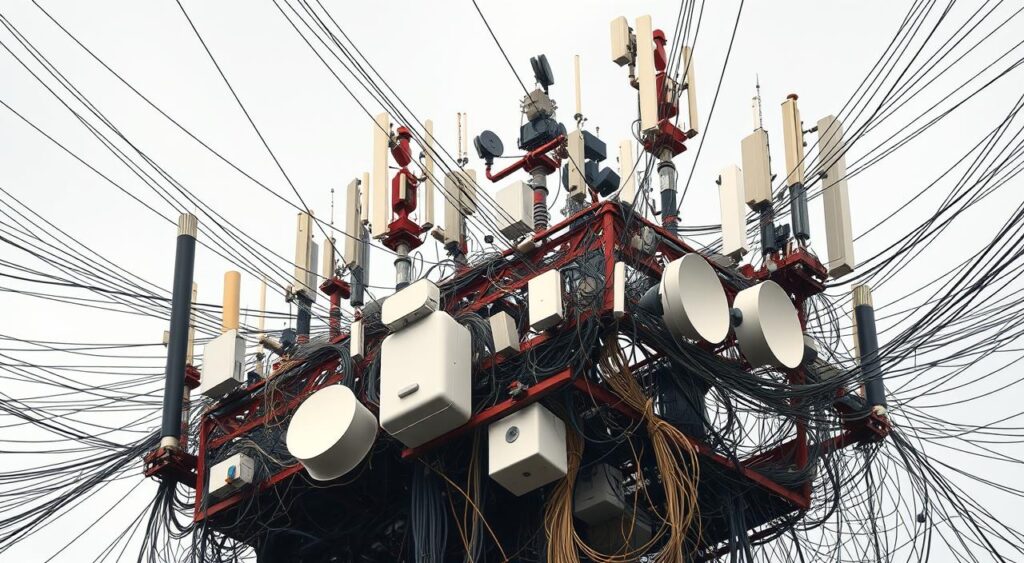
Future Trends in 5G Technology Expansion
The growth of 5G technology is set to introduce many future trends across various industries. As connectivity demands rise, next-generation technology innovations are key to this evolution. The integration of artificial intelligence (AI) enhances capabilities, opening up exciting new applications. AI, combined with 5G’s faster speeds and lower latency, promises to change how we interact with technology daily.
Next-Generation Technology Innovations
Next-generation technology innovations lead the 5G expansion. Companies like Motorola are launching devices, such as the Moto G Stylus 5G. This smartphone supports 5G and offers affordable high-speed internet, benefiting underserved areas. Educational institutions using these devices boost digital literacy, making more resources available.
Potential for Enhanced 5G Applications
Enhanced 5G applications could revolutionize industries with advanced robotics and real-time simulations. Improved connectivity will drive breakthroughs in healthcare, manufacturing, and entertainment. The partnership between Amdocs and Crnogorski Telekom shows how telecom providers aim to modernize their systems. These efforts focus on customer experience and innovation, vital in today’s competitive market.
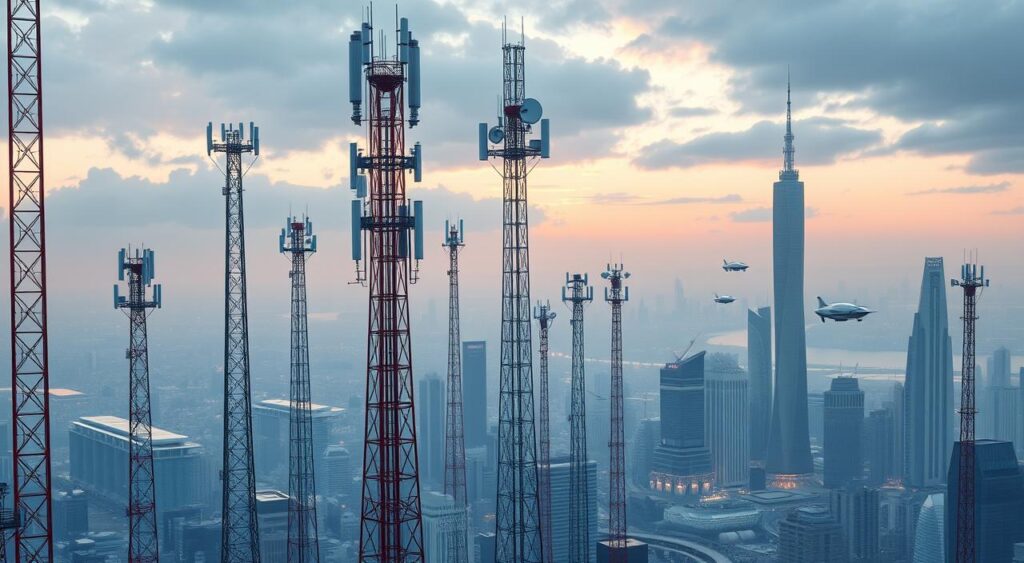
Case Studies of 5G Implementation in the US
The United States has seen significant progress in 5G technology across different sectors. Case studies reveal the vast opportunities and outcomes of this technology. Industries are now using 5G to boost efficiency and customer satisfaction.
In cities like Sacramento and San Diego, 5G is being used to improve transportation systems. It enables real-time traffic monitoring and adjusts traffic signals, cutting down on traffic and making roads safer. These examples highlight the role of 5G in urban innovation.

Companies like Verizon and AT&T are leading efforts to expand 5G coverage and speed. In Chicago, Verizon’s 5G network supports groundbreaking healthcare applications, such as telemedicine. This technology allows for faster and more effective remote consultations, improving patient outcomes.
An in-depth look at these projects uncovers key strategies:
- Collaborations between tech firms and local governments
- Investments in infrastructure for 5G networks
- Focus on user benefits to increase adoption
| City | Industry | Application | Results |
|---|---|---|---|
| Sacramento | Transportation | Smart traffic systems | Reduced congestion |
| Chicago | Healthcare | Telemedicine | Improved patient care |
| San Diego | Public Safety | Real-time surveillance | Enhanced emergency response |
These case studies show the significant impact of 5G in the US. They offer insights into how various sectors can benefit from 5G, guiding future projects towards growth and innovation.
Economic Impacts of 5G Technology Expansion
The advent of 5G technology brings more than just faster connectivity. It also sparks significant job creation and boosts economic growth. This section delves into how 5G advancements lead to employment opportunities and enhance American businesses’ competitiveness globally.
Job Creation and Economic Growth
The deployment of 5G networks requires a skilled workforce. This includes roles in infrastructure installation, maintenance, and management. The demand for such professionals creates real job opportunities. Sectors like telecommunications, IT, and networking see a surge in talent needs as businesses embrace 5G.
This increased demand prompts the development of training programs and educational initiatives. These efforts drive economic growth in local communities, benefiting the broader economy.
Enhancing Competitiveness in Global Markets
5G’s improved connectivity fuels innovation, making American companies more competitive globally. The technology’s enhanced speed and reliability enable the creation of new applications and solutions. This meets the evolving needs of consumers, driving business growth.
By leveraging 5G, companies attract the investment and resources needed for expansion. They not only excel in domestic markets but also gain an edge internationally.

| Impact Area | Details |
|---|---|
| Job Creation | Increased demand for technical skills leading to new job opportunities. |
| Economic Growth | Local communities experience a boost from employment and business investment. |
| Competitiveness | American firms can innovate more rapidly, attracting global investment. |
| Innovation | 5G capabilities enable the creation of new applications and services. |
Predicted Growth of 5G Technology in the United States
The expansion of 5G technology in the United States is poised to revolutionize various sectors, leading to substantial predicted growth in the coming years. Telecommunication providers are upgrading their infrastructure, paving the way for new opportunities for businesses and consumers.
By 2025, forecasts indicate that over 50% of mobile subscriptions in the United States will be for 5G services. This surge will be accompanied by a significant increase in 5G technology adoption. The market value is expected to exceed $300 billion by the end of the decade.
Industries like healthcare, automotive, and smart manufacturing will see substantial benefits from this growth. For example, 5G technology will enable faster data transfer and real-time communication. These advancements are critical for remote medical procedures and autonomous vehicles. They will lead to more efficient workflows and stimulate economic growth nationwide.
To illustrate the transformation, consider the following table describing the projected growth rates for various sectors influenced by 5G technology:
| Sector | Projected Growth Rate by 2025 |
|---|---|
| Healthcare | 45% |
| Automotive | 50% |
| Manufacturing | 40% |
| Entertainment & Media | 55% |

The advent of 5G technology heralds more than just improved connectivity. It marks a shift towards universal connectivity, impacting every facet of life in the United States. As the benefits become apparent, the growth momentum is expected to attract more investments. This will bolster a robust economy fueled by innovation and connectivity.
Conclusion
Reflecting on the expansion of 5G technology, it’s clear that it has the power to transform connectivity across the United States. The focus on strategic investments in quantum computing and AI-driven semiconductors shows a commitment to a strong digital infrastructure. Overcoming regulatory hurdles and public concerns is key to unlocking 5G’s full benefits in the economy, society, and technology.
The integration of quantum key distribution and advancements in quantum-secured environments highlights their critical role in securing our future. As traditional encryption faces challenges, staying informed about new standards and investments is vital. This knowledge will guide important decisions in digital environments.
In conclusion, the success of 5G technology depends on collaboration between governments, private sectors, and innovators. By working together and embracing new technologies, we can solidify 5G as a cornerstone for future advancements. This will lay the groundwork for next-generation solutions that will revolutionize connectivity.
